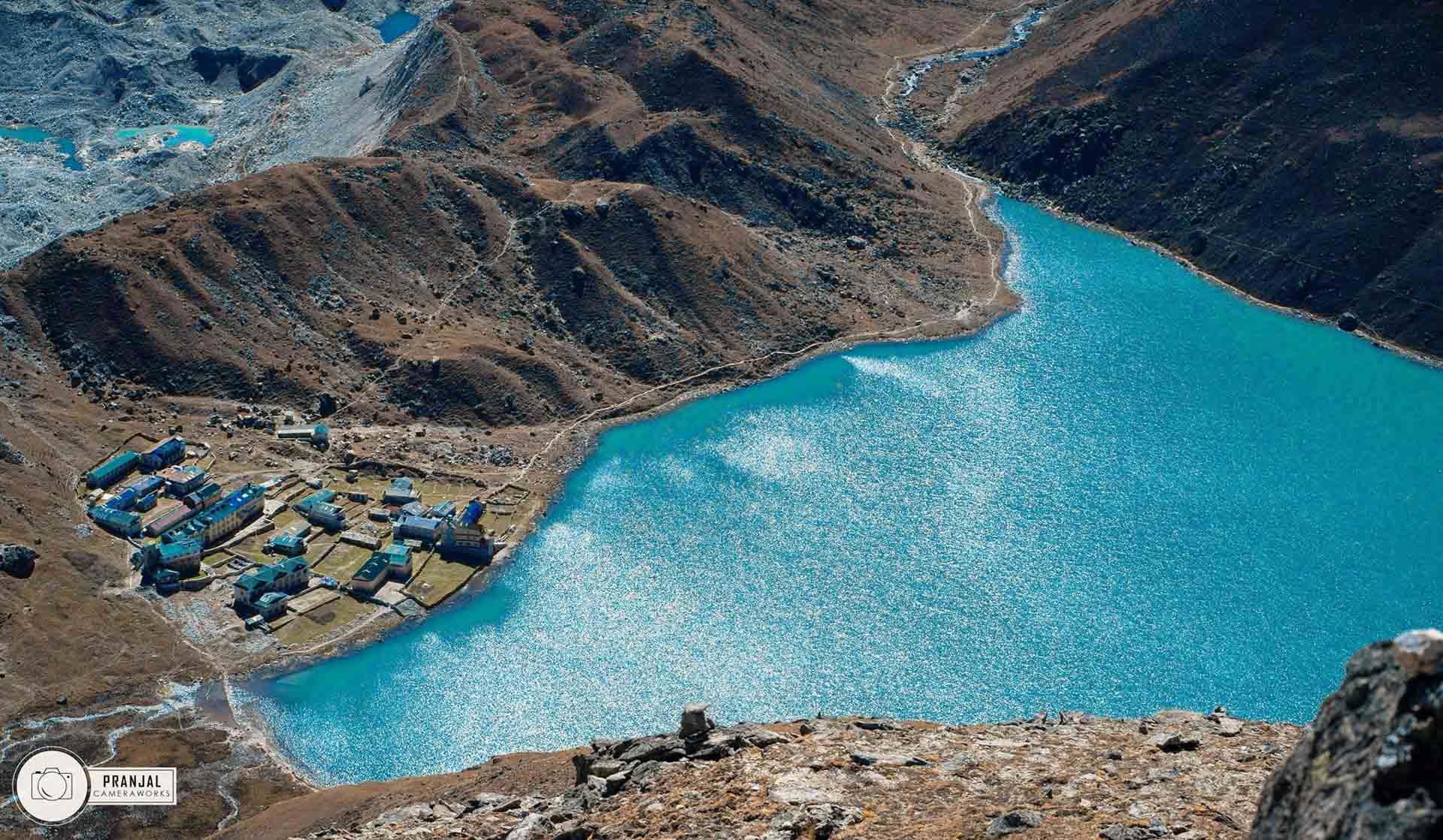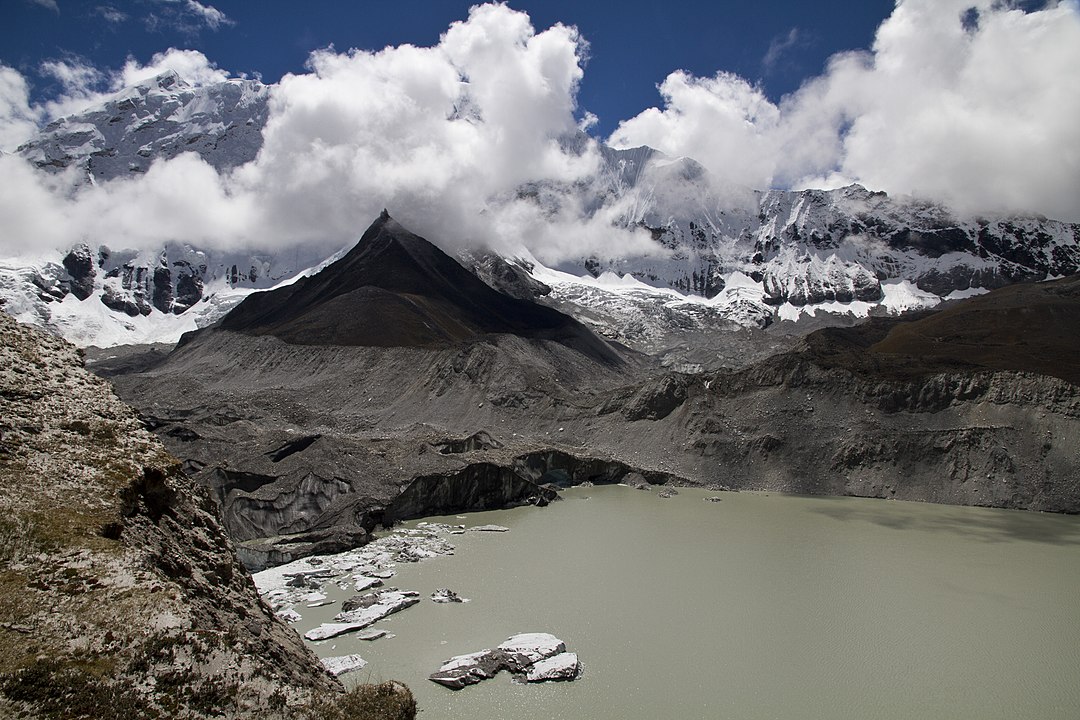
In addition to lofty peaks like Everest, Lhotse, and Cho Oyu, the Everest Region is also home to stunningly beautiful high altitude lakes. The serene calmness of these turquoise lakes contrasts beautifully with the lofty ambition of high mountains. When we go to the Everest Region, one of our favorite pastimes is seeing how the beautiful Gokyo Lakes changes colors throughout the day.
Here we present Gokyo and four other lakes of the Everest Region.
Gokyo Lakes

Gokyo Lakes is a freshwater lake system situated in the Gokyo valley, consisting mainly of six lakes: Gokyo Cho (Dudh Pokhari), Thonak Cho, Gyazumpa Cho, Tanjung Cho, Ngojumba Cho, and Kyajumba Cho. Thonak Cho is the largest lake out of them. However, if you go further up the valley, there are at least 20 other high-altitude lakes. Because of their significance, Gokyo and associated wetlands of 7,700 ha (30.0 sq. mi.) were designated a Ramsar site in September 2007.
The best thing about these lakes is that there are hotels right next to the most famous of the lakes, Gokyo Cho. Indeed Gokyo village is very charming because of the soaring sound of freshwater, reflections of crystal mountains, and the ever-changing lakes. And if it is winter, you also get to walk or skate on the lake.
If you are looking to explore all the lakes, set aside a day. If you start from Gokyo village, it will take you three hours to complete a round trip to Thonak Cho (fourth lake) and six hours for a round trip to Ngozumpa Cho (fifth lake). It is entirely worth the time as you will be rewarded with beautiful views of Cho You, Gyachung Kang, Ngozumpa Glacier, Everest, Nuptse, Lhotse, and Makalu.
It is also worth noting that a rookie mistake while planning a trek to Gokyo is planning to stay only a single day. A lot of people just immediately realize their mistake when they get here. You need at least two nights to fully appreciate the beauty of this lake system.
Altitude : 4,700 m- 5,000 m
Latitude : 27° 58′ 49″ N
Longitude : 86° 40′ 7″ E
How to go there?
You can either plan a 12 day trek to Gokyo Lakes or do a 15 days trek that passes through both Everest Base Camp and Gokyo. Alternately, it is also possible to take a helicopter to this stunningly beautiful lake.
Chola Tsho Lake / Dughla Glacial Lake

Chola Tsho lake is the best-kept secret in the Everest Region. Despite being so close to the Everest Base Camp trekking trail, very few people go there. And while the lake looks small in the picture above, it is bigger than the famous Gokyo Lake.
Here is what you need to do to see this lake for yourself:
For those doing the EBC Trek: Start early on the day when you are heading up to Lobuche from Dingboche. After an early lunch at Thukla, ask the lodge owners for a way to this lake. It is about 1.8 km to the west and will take you around 45 minutes to get there. Just make sure you do not walk uphill to the trail to Dzongla.
For those doing the EBC + Gokyo Trek: You will see this lake from above when you are heading to Dzongla from Lobuche. However, please note that the trail to Dzongla is some 300 meter above the lake. As such you will see the lake from above. If you wish to walk along it’s shores, you will have to plan accordingly.
Imja Lake

Imja Lake, located at the toe of Imja Glacier, is formed by the waters of the Lhotse Shar, Imja, and Amphu glaciers. This lake did not exist in the early 1960s and is now 2.6 km across! Considered one of the 21 most dangerous glacial lakes in Nepal, Imja Lake, with 75 million cubic meters of water, is held back by a fragile, unconsolidated terminal moraine of loose boulders and rocks.
Also, unlike the Gokyo and Cho La Lakes, this one isn’t that stunning to look at either.
However, suppose you wish to see this lake while doing the Everest Base Camp Trek. In that case, we recommend you start real early from Dingboche during your acclimatization hike to Chukung. After a quick lunch at Chukung, you will need to walk 2 more hours to see this lake. The entire day will easily take you around 7 hours both ways.
Dudh Kunda, Solu
Dudh Kunda Lake (4560m), or the Milky Lake, is located at the base of Mt. Numbur and Karyalung Glacier. In the local community, this area is known as Shorong Yul Lha, the “Protector of Solu region.” This lake is the holiest place for both Buddhist and Hindu people, and it is believed that taking a bath in the lake helps your wishes be fulfilled.
However, please note that this lake doesn’t like in the Everest Region proper, but on the lower stretches of the Everest Region called Solu. Here is an itinerary if you wish to see this lake for yourself:
Day 1: Fly or drive to Phaplu and drive to Ringmu [2,600m]. (02-03 Hours)-Tea House
Day 2: Trek Ringmu to Saharsa Beni [3,800 m]. (06-07 Hours) – Tea House
Day 3: Trek to Dudh Kunda and back to Saharsa beni [4,561 m]. (5-6 Hours)-Tea House
Day 4: Trek Saharsa to Junbesi [2,860 m]. (04-05 Hours) (Tea House).
Day 5: Trek Junbesi to Phaplu [2,413m]. (05-06 Hours) (Tea House).
Day 6: Fly or drive Back to Kathmandu [1,338m]
Altitude: 4,560 m
Lat/Long: 27.7115° N / 86.5997° E
Dig Tsho, Thame
Dig Tsho, a glacier lake formed after the 1960s, is situated at the sub-basin of the Nangpo-Tsangpo area in Bhote Koshi Valley. Its source is the Langmuche Glacier (5,400m) which originates at the foot of the northeast face of Tangri Ragi Tu (6,940 m).
In 1985, this lake outburst on a sunny August afternoon destroying several villages and killing three people. The scars are still visible in the villages of Thame and Thame Tenga and in the memories of local people. This event had specially brought awareness on both national and international levels regarding the potential danger of glacial lakes in the high Himalayas.
One has to hike for one and half hours or two hours from Thame to reach and visit the lake.







